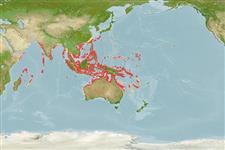Environment: milieu / climate zone / depth range / distribution range
Ökologie
seewasser riff-verbunden; tiefenbereich 3 - 30 m (Ref. 48637), usually 5 - 30 m (Ref. 27115). Tropical; 24°C - 27°C (Ref. 27115); 30°N - 30°S, 49°E - 170°E
Indo-West Pacific: Aldabra Islands, Seychelles, Maldives, Andaman Sea, Thailand, Indonesia, Peninsular Malaysia, Sabah, Singapore, Viet Nam, Philippines, Ryukyu Islands, Ogasawara Islands, Palau, ?Kiribati, Papua New Guinea, Solomon Islands, Australia, Vanuatu, and New Caledonia. Replaced by Siganus trispilos in northwest Australia (Ref. 37816).
Size / Gewicht / Alter
Maturity: Lm ? range ? - ? cm
Max length : 35.0 cm SL Männchen/unbestimmt; (Ref. 48637); common length : 20.0 cm TL Männchen/unbestimmt; (Ref. 9813)
Rückenflossenstacheln (insgesamt): 13; Rückenflossenweichstrahlen (insgesamt): 10; Afterflossenstacheln 7; Afterflossenweichstrahlen: 9; Wirbelzahl: 13. Head, body and fins orange-yellow; pale blue ocelli with darker blue margins on head, thorax and sides; spots about pinhead size, larger and more crowded on head, sometimes smaller on sides; ocelli may extend onto bases of dorsal and anal fins, and on bases of outer rays of caudal fin. Very small juveniles (up to 50 mm SL) may have vertical blue lines on side, fragmenting into the ocelli with increase in size. Orbit with a diffused-edged dark, triangular smudge; orange-brown iris Fin spines stout, pungent and venomous. Midline of thorax and ridges fully scaled.
Occurs in coral-rich areas of lagoons. Juveniles found in small schools in shallow seagrass beds and reefs; often found among Acropora corals. Adults usually in pairs on shallow coral reefs and feed on benthic algae. A food fish that is occasionally poisonous (Ref. 4537, 48637).
Life cycle and mating behavior
Geschlechtsreife | Fortpflanzung | Ablaichen | Eier | Fecundity | Larven
Woodland, D.J., 1990. Revision of the fish family Siganidae with descriptions of two new species and comments on distribution and biology. Indo-Pac. Fish. (19):136 p. (Ref. 1419)
IUCN Rote Liste Status (Ref. 130435)
Nutzung durch Menschen
Fischereien: kommerziell; Aquarium: Kommerziell
Mehr Information
NamenSynonymeMetabolismusRäuberÖkotoxikologieFortpflanzungGeschlechtsreifeAblaichenSpawning aggregationFecundityEierEientwicklung
ReferenzenAquakulturAquakultur ProfilZuchtlinienGenetikElectrophoresesVererbbarkeitKrankheitenVerarbeitungNutrientsMass conversion
Tools
Zusatzinformationen
Download XML
Internet Quellen
Estimates based on models
Preferred temperature (Ref.
123201): 24.7 - 29, mean 28.1 °C (based on 1288 cells).
Phylogenetic diversity index (Ref.
82804): PD
50 = 0.5000 [Uniqueness, from 0.5 = low to 2.0 = high].
Bayesian length-weight: a=0.01072 (0.00601 - 0.01909), b=3.17 (3.02 - 3.32), in cm total length, based on LWR estimates for this species & Genus-body shape (Ref.
93245).
Trophic level (Ref.
69278): 2.0 ±0.0 se; based on diet studies.
Widerstandsfähigkeit (Ref.
120179): hoch, Verdopplung der Population dauert weniger als 15 Monate. (Preliminary K or Fecundity.).
Fishing Vulnerability (Ref.
59153): Low to moderate vulnerability (33 of 100).
Nutrients (Ref.
124155): Calcium = 34.9 [17.2, 80.0] mg/100g; Iron = 0.648 [0.306, 1.487] mg/100g; Protein = 18.5 [17.0, 20.0] %; Omega3 = 0.1 [0.1, 0.2] g/100g; Selenium = 21.7 [8.7, 54.3] μg/100g; VitaminA = 32.8 [7.7, 133.2] μg/100g; Zinc = 1.33 [0.52, 2.82] mg/100g (wet weight);
